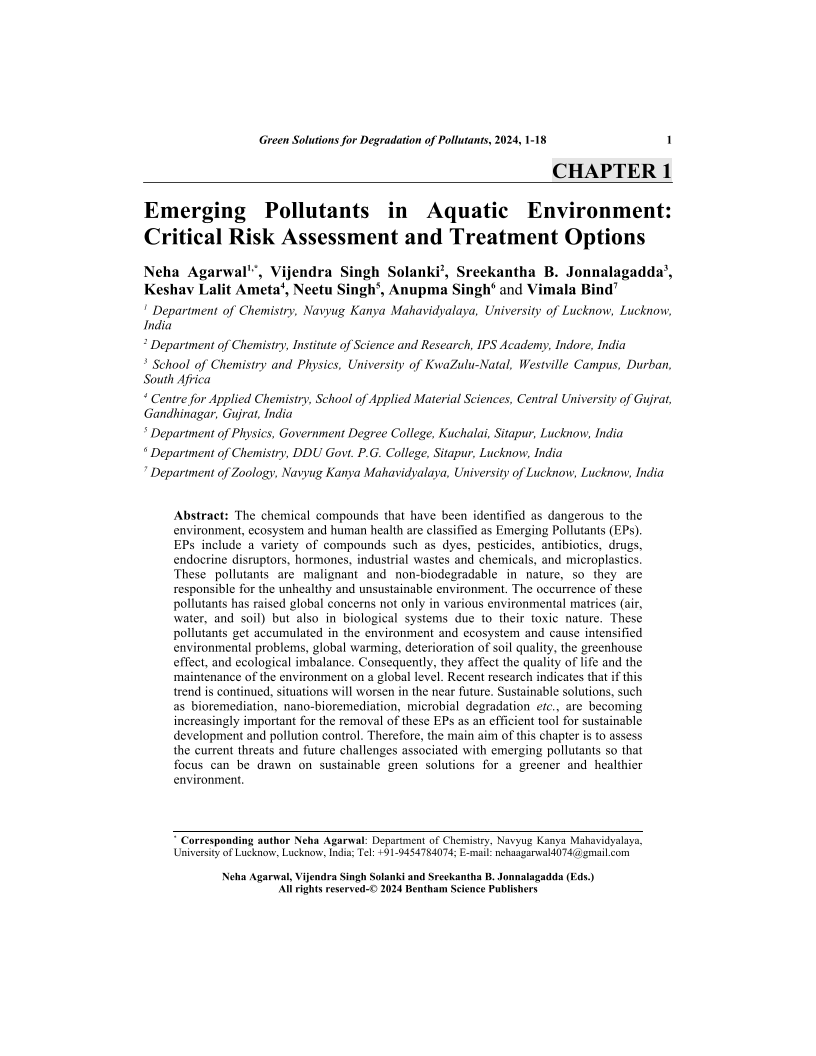Emerging Pollutants in Aquatic Environment: Critical Risk Assessment and Treatment Options

- Authors: Neha Agarwal1, Vijendra Singh Solanki2, Sreekantha B. Jonnalagadda3, Keshav Lalit Ameta4, Neetu Singh5, Anupma Singh6, Vimala Bind7
-
View Affiliations Hide AffiliationsAffiliations: 1 Department of Chemistry, Navyug Kanya Mahavidyalaya, University of Lucknow, Lucknow, India 2 Department of Chemistry, Institute of Science and Research, IPS Academy, Indore, India 3 School of Chemistry and Physics, University of KwaZulu Natal, Westville Campus, Durban, South Africa 4 Centre for Applied Chemistry, School of Applied Material Sciences, Central University of Gujrat, Gandhinagar, Gujrat, India 5 Department of Physics, Government Degree College, Kuchalai, Sitapur, Lucknow, India 6 Department of Chemistry, DDU Govt. P.G. College, Sitapur, Lucknow, India 7 Department of Zoology, Navyug Kanya Mahavidyalaya, University of Lucknow, Lucknow, India
- Source: Green Solutions for Degradation of Pollutants , pp 1-18
- Publication Date: August 2024
- Language: English
Emerging Pollutants in Aquatic Environment: Critical Risk Assessment and Treatment Options, Page 1 of 1
< Previous page | Next page > /docserver/preview/fulltext/9789815238969/chapter-1-1.gif
The chemical compounds that have been identified as dangerous to the environment, ecosystem and human health are classified as Emerging Pollutants (EPs). EPs include a variety of compounds such as dyes, pesticides, antibiotics, drugs, endocrine disruptors, hormones, industrial wastes and chemicals, and microplastics. These pollutants are malignant and non-biodegradable in nature, so they are responsible for the unhealthy and unsustainable environment. The occurrence of these pollutants has raised global concerns not only in various environmental matrices (air, water, and soil) but also in biological systems due to their toxic nature. These pollutants get accumulated in the environment and ecosystem and cause intensified environmental problems, global warming, deterioration of soil quality, the greenhouse effect, and ecological imbalance. Consequently, they affect the quality of life and the maintenance of the environment on a global level. Recent research indicates that if this trend is continued, situations will worsen in the near future. Sustainable solutions, such as bioremediation, nano-bioremediation, microbial degradation etc., are becoming increasingly important for the removal of these EPs as an efficient tool for sustainable development and pollution control. Therefore, the main aim of this chapter is to assess the current threats and future challenges associated with emerging pollutants so that focus can be drawn on sustainable green solutions for a greener and healthier environment.
-
From This Site
/content/books/9789815238969.chapter-1dcterms_subject,pub_keyword-contentType:Journal105

